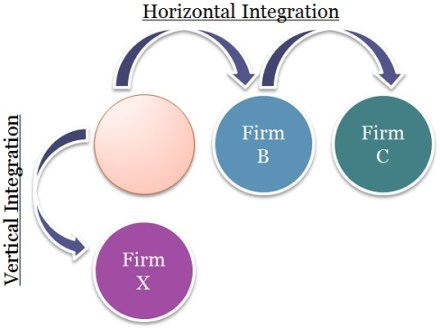Integration Growth and expansion are the two needs of every firm, irrespective of its size and nature. Firms can grow and expand themselves by way of integration. There are two major forms of integration, i.e. Horizontal Integration and Vertical Integration. Horizontal Integration is a kind of business expansion strategy, wherein the company acquires same business line or at the same level of value chain so as to eliminate competition to a greater extent.
Conversely, Vertical Integration is used to rule over the entire industry by covering the supply chain. It implies the integration of various entities engaged in different stages of the distribution chain.

Horizontal Integration
The merger of two or more firms, which are engaged in the same line of business and their activity level is also same; then this is known as Horizontal Integration. The product may include complementary product, by-product or any other related product, competitive product or entering into the product’s repairs, services, and maintenance section.
Horizontal Integration reduces competition between firms in the market, as if the producers of the product get combined they can create a monopoly. However, it can also create an oligopoly if there are still some independent manufacturers in the market.
It is a tactic used by most of the companies to expand its size and achieve economies of scale due to increased production level. This will help the company to approach new customers and market. Moreover, the company can also diversify its products and services.
Vertical Integration
Vertical Integration is between two firms that are carrying on business for the same product but at different levels of the production process. The firm opts to continue the business, on the same product line as it was done before integration. It is an expansion strategy used to gain control over the entire industry.
There are two forms of vertical integration, as described below:
Forms of vertical integration
- Forward Integration: If the company acquires control over distributors, then it is downstream or forward integration.
- Backward Integration: When the company acquires control over its supplier, then it is upstream or backward integration.

The cause of integration is to strengthen the production-distribution chain and to minimize the cost and wastage of products at various levels. The integration also enables the company to keep upstream and downstream profits and eliminate intermediaries.
Apple is the best example of vertical integration; it is the biggest and a renowned manufacturer of smartphones, laptops and so on. It controls the whole production and distribution process itself, from the beginning to the end. Another example of this is Alibaba, a Chinese e-commerce company, that owns the entire system of payment, delivery, search engine and much more.
Key Differences between Horizontal and Vertical Integration
The following are the major differences between horizontal and vertical integration:
- Horizontal Integration occurs between two firms whose product and production level are same. Vertical Integration is an integration of two firms that operates in different stages of the manufacturing process.
- Horizontal Integration aims at increasing the size of business and scale of production, whereas Vertical Integration focuses on strengthening and smoothening its production-distribution process.
- The greatest advantage of horizontal integration is that it eliminates competition between firms, which ultimately extends the market share of the company. Conversely, Vertical Integration results in lowering the cost of production and wastage.
- Horizontal Integration only brings synergy, but not self-sufficiency while Vertical Integration helps the company gain synergy with self-sufficiency.
- Horizontal Integration helps to acquire control over the market, but Vertical Integration is a strategy used for gaining control over the whole industry.
Example
Horizontal Integration
Integration of Exxon and Mobil, oil companies to increase market dominance is an example of Horizontal Integration.
Vertical Integration
Firms like Mafatlal, National Textile Corporation, etc have opened up retails stores owned by them, in order to have an effective control over distribution activities.
2 thoughts on “Integration Strategies: Horizontal & Vertical”